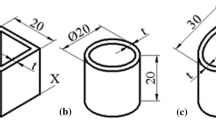Abstract
Fused deposition modeling (FDM) machines are becoming increasingly popular for producing functioning components. One of the drawbacks of used filament fabrication 3D printers is that the printed part’s surface roughness is excessively rough due to the layer-by-layer deposition of the material. Therefore, it is necessary to verify that the components have a high-quality surface finish and precise dimensions. The purpose of this study is to identify the optimal layer thickness that may be used to manufacture components with both high surface quality and accuracy of dimension. Six different layer thicknesses of FDM were used to manufacture the test parts (0.1, 0.15, 0.2, 0.25, 0.3, and 0.35 mm). The optimum layer thickness levels for dimensional accuracy were discovered to be the same as that of surface roughness. The results of the experiment were confirmed by fabricating parts with the optimal layer thickness that had been determined. Reduced printing layers increased the specimens’ surface smoothness. The smaller layer thickness was shown to be required for greater overall dimensional accuracy, according to the findings.
Access this chapter
Tax calculation will be finalised at checkout
Purchases are for personal use only
Similar content being viewed by others
References
Alafaghani A, Qattawi A (2018) Investigating the effect of fused deposition modeling processing parameters using Taguchi design of experiment method. J Manuf Process 36:164–174
Altan M, Eryildiz M, Gumus B, Kahraman Y (2018) Effects of process parameters on the quality of PLA products fabricated by fused deposition modeling (FDM): surface roughness and tensile strength. Mater Test 60(5):471–477
Bakır AA, Atik R, Özerinç S (2021) Effect of fused deposition modeling process parameters on the mechanical properties of recycled polyethylene terephthalate parts. J Appl Polym Sci 138(3):49709
Beniak J, Križan P, Šooš Ľ, Matúš M (2019) Research on shape and dimensional accuracy of FDM produced parts. IOP Conf Ser: Mater Sci Eng 501:12030
Boparai KS, Singh R, Singh H (2016) Development of rapid tooling using fused deposition modeling: a review. Rapid Prototyp J 22:281–299
Casavola C, Cazzato A, Moramarco V, Pappalettere C (2016) Orthotropic mechanical properties of fused deposition modelling parts described by classical laminate theory. Mater Des 90:453–458
Chacón JM, Caminero MA, García-Plaza E, Núnez PJ (2017) Additive manufacturing of PLA structures using fused deposition modelling: effect of process parameters on mechanical properties and their optimal selection. Mater Des 124:143–157
Dave HK, Patel ST (2021) Introduction to fused deposition modeling based 3D printing process. In: Fused deposition modeling based 3D printing, pp 1–21
Dev S, Srivastava R (2021) Optimization of fused deposition modeling (FDM) process parameters for flexural strength. Mater Today: Proc 44:3012–3016
Doshi M, Mahale A, Kumar Singh S, Deshmukh S (2022) Printing parameters and materials affecting mechanical properties of FDM-3D printed parts: perspective and prospects. Mater Today: Proc 50:2269–2275
Hafsa M, Ibrahim M, Wahab MS, Zahid M (2013) Evaluation of FDM pattern with ABS and PLA material. Appl Mech Mater 465–466:55–59
Hikmat M, Rostam S, Ahmed YM (2021) Investigation of tensile property-based Taguchi method of PLA parts fabricated by FDM 3D printing technology. Results Eng 11:100264
Kovan V, Altan G, Topal ES (2017) Effect of layer thickness and print orientation on strength of 3D printed and adhesively bonded single lap joints. J Mech Sci Tecnol 31(5):2197–2201
Kristiawan RB, Imaduddin F, Ariawan D, Arifin Z (2021) A review on the fused deposition modeling (FDM) 3D printing: filament processing, materials, and printing parameters. Open Eng 11(1):639–649
Milde J, Jurina F, Peterka J, Dobrovszký P, Hrbál J, Martinovič J (2021) Influence of part orientation on the surface roughness in the process of fused deposition modeling. Key Eng Mater 896:29–37
Mohamed OA, Masood SH, Bhowmik JL (2015) Optimization of fused deposition modeling process parameters: a review of current research and future prospects. Adv Manuf 3(1):42–53
Mohamed OA, Masood SH, Bhowmik JL (2018) Investigation of dimensional variation in parts manufactured by fused deposition modeling using gauge repeatability and reproducibility. IOP Conf Ser: Mater Sci Eng 310:12090
Nancharaiah T, Raju DR, Raju VR (2010) An experimental investigation on surface quality and dimensional accuracy of FDM components
Nidagundi VB, Keshavamurthy R, Prakash CPS (2015) Studies on parametric optimization for fused deposition modelling process. Mater Today: Proc 2:1691–1699
Pandžić A, Hodžić D, Kadrić E (2021) Experimental investigation on influence of infill density on tensile mechanical properties of different FDM 3D printed materials. Parameters 3:4
Pérez M, Medina-Sánchez G, García-Collado A, Gupta M, Carou D (2018) Surface quality enhancement of fused deposition modeling (FDM) printed samples based on the selection of critical printing parameters. Materials 11:8
Ramli F, Nazan M, Alkahari MR, Sudin MN, Mat S, Khalil SN (2018) Dimensional accuracy and surface roughness of part features manufactured by open source 3D printer. J Eng Appl Sci 13
Akande SO (2015) Dimensional accuracy and surface finish optimization of fused deposition modelling parts using desirability function analysis. Int J Eng Res Appl 4(4):196–202
Vaes D, Van Puyvelde P (2021) Semi-crystalline feedstock for filament-based 3D printing of polymers. Prog Polym Sci 118:101411
Wu J (2018) Study on optimization of 3D printing parameters. IOP Conf Ser: Mater Sci Eng 392:62050
Author information
Authors and Affiliations
Corresponding author
Editor information
Editors and Affiliations
Rights and permissions
Copyright information
© 2023 The Author(s), under exclusive license to Springer Nature Switzerland AG
About this chapter
Cite this chapter
Jasim, M.F., Huayier, A.F., Abbas, T.F. (2023). Investigation of the Effect of Surface Roughness and Dimensional Accuracy on the Layer Thickness of PLA Parts Produced by the FDM Process. In: Abu Bakar, M.H., Razak, T.A.b.A., Öchsner, A. (eds) Progress in Engineering Technology V. Advanced Structured Materials, vol 183. Springer, Cham. https://doi.org/10.1007/978-3-031-29348-1_3
Download citation
DOI: https://doi.org/10.1007/978-3-031-29348-1_3
Published:
Publisher Name: Springer, Cham
Print ISBN: 978-3-031-29347-4
Online ISBN: 978-3-031-29348-1
eBook Packages: Physics and AstronomyPhysics and Astronomy (R0)




